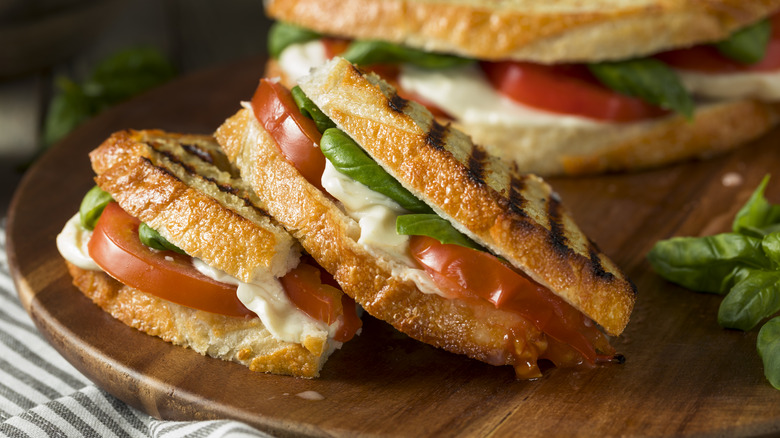Panini Vs Panino: Is There A Difference?
Italy is often called the land of pasta and pizza, but if you've ever visited, you know its food history and culture are more than just that. From the northernmost region of Alto Adige to the southernmost of Sicily, there's endless gastronomy to discover if you're willing to stray from the typical tourist's menu. However, eating like an Italian local certainly requires a bit of research and preparation, particularly when it comes to the Italian language. Just like how lots of Italian-American food is notoriously un-Italian (see: spaghetti and meatballs), there are lots of words that roll off the tongue in the U.S. that, in Italy, are grammatical mistakes. For starters, the difference between "panini" and "panino." In the U.S., a panini refers to a single pressed sandwich, but if you ask for a panini in Italy, you might be served two — or even three — since it is the plural form of the singular panino.
Of all the best panini recipes you'll encounter in the U.S., you're unlikely to find anything similar in Italy. American paninis are typically hot sandwiches pressed on a panini press. From grilled cheeses to tuna melts, the panini is a staple of American cuisine. But the only thing that makes an American panini somewhat Italian is its name: Both panino and panini come from the Italian word pane, which means bread. Beyond the grammar, the Italian panino is quite different from your typical American panini for a number of reasons.
Iconic Italian panini
While Italian panini vary regionally, the ones you'll find in a cafe or a paninoteca — a sandwich shop — follow a similar composition. If they're made-to-order, they're often served cold and on bread like ciabatta, focaccia, or a rosetta roll. However, many Italian cafes and bars prepare them in advance and serve them throughout the day, too. These are often heated up on a panini press like in the U.S.
Whether they're hot or cold, Italian panini are almost always stuffed with cured meat, cheese, vegetables, and occasionally dressing, like pesto or olive oil. What makes a panino a panino, though, is simplicity: you'll never see an authentic one with more than two or three ingredients.
Beyond simplicity, regionality also makes even the humble panino a food to seek out in Italy. You can find a basic panino just about anywhere: Sandwiches stuffed with mozzarella and tomato, or simple prosciutto crudo, and these hit the spot. But in Florence, you'll find the iconic lampredotto, a panino made with broth-soaked tripe and salsa verde. In Sicily, there's the pani ca meusa, an ultra-regional sandwich made with cow spleen, lung, and caciocavallo cheese. And in central Italy, you'll never be too far from a fragrant porchetta panino stand. If you're impartial to the American panini, give the Italian panino a shot. There are plenty of variations all throughout the Bel Paese, making it a great way to explore Italy's culinary magic, one panino at a time.

